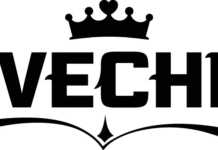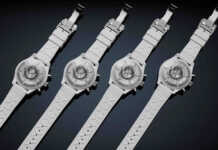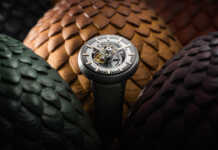
Consumers driving the biggest mechanical watch craze in decades are looking for more expensive timepieces, and Swiss makers are receptive to everything from entry-level brands to the most exclusive independent manufacturers. Take Oris Watches, a brand known for its affordable dive watches. Co-CEO Rolf Studer said the shift to high-end models has boosted the average retail price from 2,000 Swiss francs ($2,038) to about 2,400 Swiss francs in three years. This has prompted the company to produce more watches with in-house developed movements, such as the ProPilot X Calibre 400 with a titanium case and bracelet, which retails for CHF 3,900.
The pandemic has sparked an unprecedented surge in interest in luxury watches, as a new generation of collectors and enthusiasts stuck at home during lockdown crave cutting-edge timepieces online. Today, watch exports from Switzerland, the center of the global watchmaking industry, are approaching record levels. Watches priced above CHF 3,000 are driving prices up as buyers become more educated and look for higher-quality movements.
A Rolex spokesperson confirmed that Rolex raised UK prices by an average of 5% on September 1. The rise came after the pound fell below $1.15 against the dollar, near its lowest level since 1985.
“There is a greater demand for jewellery, tourbillons and minute repeaters,” said chief executive Edouard Meylan, referring to watches with gem-set or complicated movements.
Frederique Constant, the Swiss brand of Japan’s Citizen Watch Company, is synonymous with entry-level fashion mechanical timepieces and is on the rise. The brand reversed course after a slump in sales in 2020, when the early stages of the pandemic briefly brought retail sales and in-store production to a standstill.
While Frederique Constant starts at around €500, the brand is struggling to keep up with demand for watches starting at €2,500.
“The rich are getting richer, the poor are getting poorer, the middle class is being squeezed. You have to adapt,” Eggedin said.
Finding the right price point and having a specific niche is important for watch brands, especially those with a loyal following. Cartier, for example, attempted a few years ago to shift more of its portfolio to high-end watchmaking, a move that was lauded by die-hard watch enthusiasts but angered some customers who had come to appreciate the brand’s more affordable offerings, such as the Tank model.
While Frederique Constant starts at around €500, the brand is struggling to keep up with demand for watches starting at €2,500.
“The rich are getting richer, the poor are getting poorer, the middle class is being squeezed. You have to adapt,” Eggedin said.
Finding the right price point and having a specific niche is important for watch brands, especially those with a loyal following. Cartier, for example, attempted a few years ago to shift more of its portfolio to high-end watchmaking, a move that was lauded by die-hard watch enthusiasts but angered some customers who had come to appreciate the brand’s more affordable offerings, such as the Tank model.
Last week, watch industry executives gather in Geneva for an industry event to keep the industry enthusiastic. The consensus was that they had no intention of dropping entry-level models despite the average price increase.
From their point of view, the cheapest timepiece is crucial to winning new customers for the brand. The trick is to then move those same customers up the value chain to the pricier model.
“We’ve been talking to regular people who don’t want or can’t spend $10 on a watch, and we’ll continue to do so,” Oris’ Studer said. “It’s part of our ethos.”















